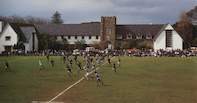Rhodes Scholarships
In February 1902 the results of the first Rhodes Scholarships were posted. Two boys scored 180 and 172 marks respectively, and it was decided to divide the scholarship between the two.

Cecil John Rhodes approved of this and increased his donation to Bishops to £300 a year. In a letter to Archbishop West Jones in which he enclosed a cheque for £1 800 - to provide for the first six years - he wrote, 'I am thankful to you for undertaking the experiment, which is a scholarship for a combination of mental, moral and physical qualities.
Who knows, it may be the grain of mustard seed which produces the largest tree?' A few weeks later Cecil John Rhodes was died and the legacy of his scholarship 'experiment' was passed on in perpetuity to young students throughout the world.
The Bishops boys who became the first Rhodes Scholars were W Farquhar Yeoman and Frank Reid. Both studied law, and Frank Reid went on to become a leading South African barrister and King's Counsel, an author (Footslogging in East Africa, published in 1918 by Maskew Miller, Cape Town), a well-known sporting personality and historian - he wrote a history of the Western Province Cricket Club as well as one of cricket at Bishops - and a passionately loyal Bishops Old Boy who almost single-handedly built the Old Diocesans' Union into the strong and supportive organisation it is today.
Amalgamation with SACS
At the turn of the century the euphoria at the end of the South African War gave way to depression and hard times. Incomes dropped and so too did the number of pupils at Bishops.
The rival South African College (SACS), which appealed to a broader spectrum of potential pupils, was flourishing, with Cape Town city representation on its council supplying the advantage of financial grants; indeed, there were strong recommendations that SACS become a fully fledged university. Bishops was in danger of being overshadowed out of existence.
To save the situation the school governors had to consider the unthinkable — an amalgamation with SACS. A lively meeting of the Bishops council committee in April 1905, however, solidly vetoed this idea. It was recorded by the principal, Canon W Owen Jenkins, successor to Canon Brooke, that the governors had no intention of allowing the school to become 'a lodging house' for SACS.
Ally of Bishops
Desperately, Bishops looked to England - the Archbishop of Canterbury - and then to the Rhodes Trustees for financial help. There was no response from either. In 1910, with the advent of Union and a National government that might not look favourably on denominational establishments, it seemed unlikely that Bishops would be able to obtain any assistance from the state.
Again, the question of an amalgamation with SACS came up, and a formal agreement seemed imminent that Bishops' upper classes would be transferred to SACS at the end of that year. Bishops was about to go under.
But the struggling school was not without friends and champions in high places. OD John X Merriman advised strongly that Bishops should retain its individuality and avoid amalgamation or any move that might put it under any obligation to the government. Government assistance, he argued, carried with it government rules and limitations.
General Louis Botha, the Union Prime Minister, who was politically and personally motivated towards unity between England and the Afrikaner, turned out to be a staunch ally of Bishops. He sent two of his sons to the school and persuaded at least two of his cabinet colleagues to do the same. For a time, then, Bishops could boast a prime minister on its parents' roll.
Legendary Headmasters
In 1919 Reverend Harold Birt inherited a school that was demoralised and run down; the buildings were seedy and discipline was slack. Birt, however, proved more than man enough to tackle the rejuvenation of Bishops.
He began an immediate overhaul of the administration and staff and impressed upon the college council the need for improved facilities and new buildings.
Birt's insistence prompted the council to formulate a long-term policy on the development, composition and organisation of the school, a policy that continued with successive principals from that time, to form the basis of the Bishops of today.
It laid down methods of house catering and the position of housemasters, and recommended the organisation of day boys under day-boy tutors. It also determined the educational policy to be followed, and projected its recommendations to future building requirements and facilities such as a chapel, sanatorium, cricket pavilion, new swimming bath, tuck shop, garages and a rifle range.
Birt pioneered the post-matriculation class and the removal of the junior certificate examination, which he considered superfluous and diversionary, from the school curriculum. Hubert Kidd, who was to succeed Birt in 1943, broke with tradition by becoming the first non-clerical principal of Bishops.
Hubert Kidd's firm and guiding hands were to carry Bishops steadily through 21 years of consolidation and development before passing on the responsibility to his successor, Mr AWH Mallett.
The distance from Bishopscourt to Rondebosch is not a long way but the Bishops of the 21st century - an elegant, roomy campus of solid and dignified buildings, the Founders block echoing the early era, School House the later Baker-inspired style, and the post-war additions complementing the complex set out in leafy green surrounds of 26 hectares - is a far cry from the school's beginnings in Maynier's cottage.